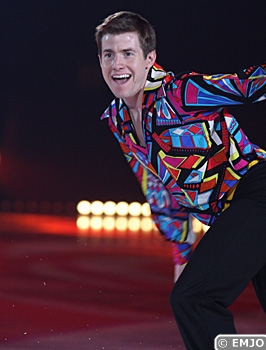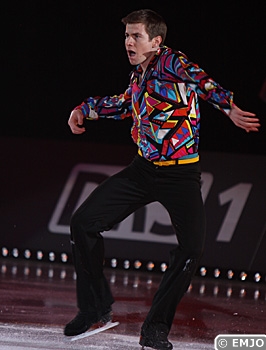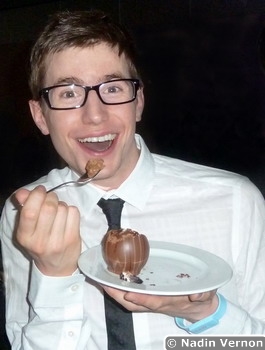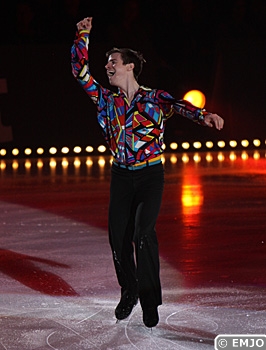Jeffrey Buttle: "I really enjoy the process of making up programs"
 February 23, 2011
By Nadin Vernon
Photo © Eva
Maria Jangbro (EMJO), Nadin Vernon
 Jeffrey Buttle’s involvement in Art on Ice really added a spark to this year’s shows. The 2008 World Champion from Canada engaged the crowd with his musicality and beautiful expressive skating. I caught up with Jeffrey to talk about his time in Zuerich, his involvement in Stars on Ice and his choreography work.
Jeffrey Buttle’s involvement in Art on Ice really added a spark to this year’s shows. The 2008 World Champion from Canada engaged the crowd with his musicality and beautiful expressive skating. I caught up with Jeffrey to talk about his time in Zuerich, his involvement in Stars on Ice and his choreography work.
It’s your first time at Art on Ice, how are you finding it?
It’s amazing. Before I came here, Shae-Lynn Bourne actually told me that once I do this show, I’ll never do a show quite like it and it’s true. When I got here and saw the set, I was so impressed. It’s a real production, it’s not just a skating show, it’s incredible and to be part of it is really cool.
You showed a pre-existent number here, Sunglasses At Night plus a new one, Enough is Enough.
Yes, I think it was Gary [Scott, Musical Director] who had written to me and said we could do a pre-existent program and perform it live. They gave me the option and so I thought Sunglasses at Night would be cool and it was so much fun. Gary and his band were able to recreate the sound and the essence of the program. And to get here and rehearse that with the huge video screen, with the dancers, Gary singing, it was crazy. And the Donna Summer program they assigned to me. Luckily I had an old costume that fit the music appropriately, it’s very colourful.
Were you able to identify with the Donna Summer song that was assigned to you right away?
Yes, I was able to identify with it immediately because I knew who Donna Summer was, we performed to Donna Summer at Stars on Ice actually. I was very much aware of her music and a fan of it. It’s just really fun music, it doesn’t matter if it’s a new generation who doesn’t know who she is or the generation that knows and loves her, it’s just fun music and such skateable music, too.
 Who choreographed your programs?
Who choreographed your programs?
I put my own together for the Donna Summer piece and David Wilson choreographed Sunglasses at Night. We only had two run throughs to the live music, so not a lot, but thankfully everyone came so prepared to this show, and Donna was right on with the versions that we were given, so it was great.
You’ve been touring with Stars on Ice for many years, how does it compare to Art on Ice?
The production is totally different. I think they just have an incredible budget here and really put the money into great things. It really is a full production, Stars on Ice I would consider more of a skating tour and there aren’t many of them out there but this caters to so many other people. It’s more of a show, or a variety show I guess.
Recently you also got involved in doing some choreography for Stars on Ice, how did that come about?
It was very exciting. Last year was the first year I worked with Renee Roca, she was the Assistant Choreographer last year. They asked her to be the Head Choreographer this year and she contacted me and said that ideally she would like me to be the Assistant Choreographer. I was completely caught off guard, I really enjoy the process and maybe she realised that, she must have seen it last year, I really get into it. I love standing there and making up programs and having fun with it, I think she realised that and that’s why she asked. So I agreed right away, and then went to LA and we spent two weeks just putting an entire show together. Lake Placid was tricky this year because normally we have two weeks with all the skaters to put the show together before the opening night, and this year we had three days.
And you have quite a few group numbers at Stars, right?
Yes, there are about six group numbers in the show, so those are the ones we’re responsible for, and there are a lot of steps to know. It was intense, we were at the rink probably from about eight in the morning until nine at night, just trying to get these numbers done. So the opening night was a bit scary but I think what we did is really going to develop into something great.
Do you get to choose the music for the group numbers?
The music is chosen by the Directors and Renee and then I come in and work with what I’m given.
And how do you assign the skaters for each number?
That’s when I arrive, we start to figure that out. There are certain numbers that are given, everyone’s going to be in the opening, everyone’s going to be in the finale. And then of course it depends on skating order. If Evan’s going to close the show then we know we’re not going to have Evan for the beginning of the finale and you work accordingly. But there are a couple of different numbers, where we just pick the skaters that we feel might fit. So if it’s a character piece, obviously we’re going to pick Kurt [Browning], he’s such a good character skater, we use him. If there’s a really beautiful number, we want to pick someone who has nice clean edges and nice lines, so we discuss who would be best once we arrive in LA.


I can imagine it being hard for single skaters to do group numbers as you’re not used to watching out for others. How do you teach this?
It’s not something you can teach right away, we really try and stress the importance of it when we train those numbers but really it takes a few years to be on tour and do group numbers to realise that you’re not just skating the number, you also have to be aware of who’s in front of you, who’s beside you, are you in line. It takes a while to get used to and it’s something that I’m now starting to get used to and I’ve been on tour for six years. If you have a cast of skaters like David [Pelletier] and Jamie [Salé] who have done it for a while, then they help the others a bit, too.
Is there anything you’ll be taking back from this show?
I find that the show here, Art on Ice, they’ve really done a good job at making it three dimensional. I feel like it opens up to the rink better, it’s not what’s going on on the ice, the massive TV screen is really cool, adds so much. The dancers, the special effects, obviously if Stars could have that kind of budget, it would be amazing.
Did you get to see much of the actual show here?
When I’m not warming up or getting ready for my number, I’m at the side just watching. And every time I watch a number – this is what I love – I see something new, like in the dress rehearsal, I thought: Oh my god, I didn’t realize Stéphane was in his own video, so little things like that.
 Let’s talk a little bit about what else you’ve been up to since retiring after winning the World Championships in 2008.
Let’s talk a little bit about what else you’ve been up to since retiring after winning the World Championships in 2008.
I retired, went on tour and I’ve been doing shows all over the place, it’s been keeping me busy and then when I’m home for periods of time, which is usually Spring/Summer, it’s a good time to do choreography, so I’ve been working as a choreographer with kids and actually just before I came here I was at the Canadian Nationals, because I had six programs there that I choreographed.
OK, so you’re pretty much still involved 100% in skating.
Oh yes. And I’m sure that for the rest of my life I’ll be involved in skating in that sense. Choreography is also something I can do when I’m a little bit older. I think I’ll have a life outside of skating and might end up going back to university and getting an actual job, but for now this is what I do and love.
What’s it like going to competitions and being there as a choreographer?
I don’t think it’s as stressful as being a coach. I generally just sit in the stands and I just watch them do what they do. It’s still a little bit nerve-wrecking though because you’re not in control of what they do. That’s a hard thing, at least when I was on the ice on my own and I made a mistake, I knew it was my mistake and I knew what I did wrong and how to fix it.
Are you reminded of your own competition days?
Honestly, what goes through my mind is ‘Thank god, I don’t have to do that anymore’. I always had that sick feeling in my stomach when I competed, especially when I skated late in the competition. I would get off from the warm-up and that was the worst for me, waiting to go out to skate. And I remember so many times what was going through my mind was ‘why do you do this to yourself, it’s so stressful’. And inevitably, once I was out there and I competed I was like ‘ok, that was totally worth it’. But I’m still glad I don’t have to deal with that part anymore.
Did you use to watch your competitors?
Never, no.

So you never actually got to see any skating while you were competing, is that quite nice to now be able to just watch and enjoy the sport?
Absolutely. I’d always be able to watch my competitors at practices but I’d never actually sit down and watch a men’s competition and see it all. So yes, I’m a skating fan, of course I love skating.
Do you see things now that you maybe weren’t able to see before?
I think I just allow myself to appreciate it a lot more. I think when you’re a competitor you also look at what the others aren’t doing so well. I mean it wasn’t like I was constantly picking out my opponent’s faults but it’s just something you do as a competitor where you think ‘Ok, I can do that better’, just trying to pump yourself up in a sense. So now I can just sit back and appreciate it more and be like ‘Wow, that was a massive triple Axel he just did, that was great, wonderful’. I don’t think I allowed myself to be so complimentary of my competitors when I competed.
How old are the skaters you work with on choreography?
They are as young as eleven and probably as old as in their twenties.


I guess the younger ones have more input from you or their coaches when it comes to music but the older ones want to choose their own?
Exactly, which I love. It’s fine with the younger ones, I’ll watch them skating and then think of which kind of music would be more appropriate for them, but I love it when the kids themselves have input even if I sometimes want to encourage them into a slightly different direction. I love it, it means they’re passionate about what they want to skate to and that means you’re going to get a lot out of them.
How do you come up with moves that are personal to each skater rather than having the same standard choreography for everyone?
You have to work within their style. If you’re doing a move and it’s just not them then you obviously have to modify it a bit. And when you’re working with someone new, it’s very much trial and error, you have to play for a while before you can get comfortable with their movement. I see them for a brief period of time, and then they go and train and I’ll come and do some touch-ups but inevitably if something doesn’t work then they change it. I wish I could be with them more often.
So how much time do you actually spend putting together a program?
Usually I prefer it if they can come to Toronto, occasionally I’ll go to Montreal. And then we probably spend about a week per program or sometimes we can do two programs per week, and I’ll see a skater for about three hours a day.
 When you then get to the competition and see them skate their program, is it very different from what you had originally put together?
When you then get to the competition and see them skate their program, is it very different from what you had originally put together?
It can be and a lot of that is the coaching style. If the coach is very adamant that they stick to the choreography and they train it that way then I’ve often gone to competitions and just been like ‘wow, they didn’t change a thing, they were really dedicated to keeping the choreography’ and then other coaches like to change things. I understand that sometimes they have to switch the order of jumps, but then often the choreography falls to the wayside. I’ve often gone to competitions and thought oh, that wasn’t at all how we did it. But it’s the nature of the beast.
Do you have to keep up with all the rule changes?
Yes (smiles). This year was a bit of a nightmare actually with the rule changes especially within the forward sequences. I mean it was a yea and a nay for the men. We got to do the choreographic step sequence which we had a lot of fun with. No rules, just really musical. That was a lot of fun, but then the actual step sequence, they kept changing it, adding the one foot throughout and then there was the combination of steps with the combination of steps not being rewarded in competitions. I think I did about three different forward sequences for my students this year and it was just horrendous. I just wish, and I’m sure that someone’s brought this forward to the ISU, that the rules would be made at World’s. Or right after World’s can we not have a meeting, figure out what worked and what didn’t work. Because now it’s a nightmare because everyone gets their choreography done April, May, June and the rules don’t come out until mid-June sometimes, so it’s frustrating but I mean you work within the restraints.
Do you do all the choreography on ice or some off the ice, too?
Most of it is done on ice, especially when we’re piecing it together and sort of framing the program, that’s all done on the ice. Sometimes we do positions off-ice too, though. I guess when you’re comfortable with the choreographer, that’s when you can sort of play with those different obstacles. With David [Wilson], we’ve choreographed almost entire programs without putting the skates on. He just feels like he can move a lot better on his feet, and it’s a lot more challenging for me because I’m trying to do what he’s doing without skates on. So that comes later, when you’re comfortable with a choreographer and you know how they move and what they want.
 How much training do you do yourself these days, you’re still showing your triples.
How much training do you do yourself these days, you’re still showing your triples.
I still train a little bit. I do maybe an hour on my own a day on the ice, it’s not a lot but it’s enough to maintain. Obviously more if a show is coming up. Before if I went two days without skating I would freak out but now it’s ok if I’ve been on the ice but I haven’t jumped. And I think ok, it’s been five days so maybe I should have a session for myself. I’m just a little bit more relaxed about it now. Choreography is usually most of my attention when I’m at home, so it’s usually one hour on my own and then maybe six hours of choreography. I actually spend more time on the ice now than I did before, it’s just that most of it is for other people.
Do you still train with a coach?
No, not really. I do work at the rink with my coach, so I’ll still do jump sessions while my coach is on the ice and he’s been great, he’ll still come up and always says to let him know if something needs to be tweaked a little bit or he’ll say if something he saw was good. So it’s cool, we have a much more relaxed relationship now.
And you still train off-ice, too?
Oh yes, of course. I’m still at the rink in Toronto, at the Cricket Club and I do a lot of work there and use the gym there. I just don’t have a personal trainer anymore, I do my own thing.
You just mentioned that you went to Canadian Nationals and saw Patrick Chan win there. Do you think he’s going to be the new World Champion?
Oh my god, if you were there and saw the way he competed; there’s no way that anyone could beat that. It was just insane, unreal. I’ve never seen any men compete like that in my whole career, it was beautiful. He does all the tricks and there are others doing big tricks like his, but he does it with transitions and barely a cross-cut.
What are your plans when you fly back home?
I have to do some choreography as soon as I get back. I have to get a program done for myself for Stars on Ice and other than that I’ll just be doing programs for other kids.
Best of luck with all the shows and thanks for making time to talk.
Thank you!





